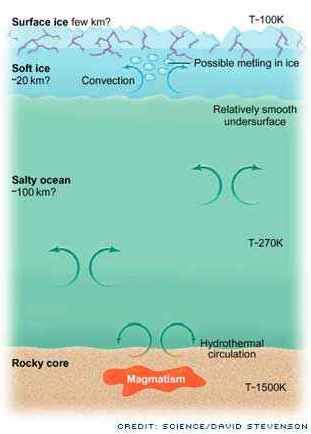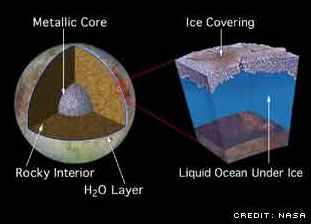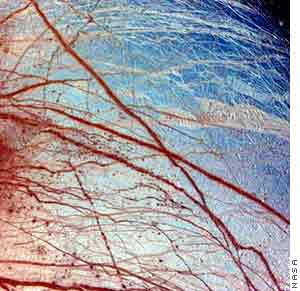
|
Schematics for Europa's interior, with a global layer of liquid water. The probably suitable for life temperature of the water is due to the tidal heating of Europa by gravitational forces from nearby massive planet Jupiter. The ocean of water is thought nearly twice as voluminous as all of Earth's oceans. The overlaying ice is expected to be at least half a mile (a kilometer) thick, and perhaps much more.

|
One possible scenario for the interior dynamics of an Europan ocean. The temperature of this liquid water could be perfectly suitable for life at least at some depth.
On Earth, microorganisms live at all kinds of conditions of temperature and pressure. Europa's crust also heats up, causing liquid water to ooze to the surface and then re-freeze as surface ridges narrow, raised strips of crust. Such heating may also provide a potential habitat for living organisms.

|
In the search for microbial life on Jupiter's icy moon Europa, the idea emerged, that heavy doses of lethal radiation surrounding the massive planet might spur chemical reactions on its tiny satellite, providing fuel for life in the suspected liquid ocean below.
In a paper in the January 27 issue of the journal Nature, Christopher Chyba of the SETI Institute lays out a novel method by which biology might arise. Chyba explained, fostering life as we know it is something like operating your Chevy. You need fuel and a little oxidant. In a car, gasoline is the fuel, combining with oxygen during burning to generate useable energy. Life operates similarly: Playing the part of oxygen are various oxidants (chemical agents that don't always contain oxygen) that are produced, typically, by photosynthesis.
Europa has in recent years been nominated by numerous exobiologists as the likeliest candidate in our solar system for extraterrestrial life, however teensy a form it might take.
Finding even the faintest life form would imply that life can arise amid almost the old condition of the presence of liquid water, and that life could be ubiquitous in the universe.
Seafloor hydrothermal vents have been suggested as a possible energy source; after all, they support life on Earth. But oxidants are still needed, and in Earth's oceans they migrate down from the surface. No one had determined where oxidants might originate on Europa yet.
But Chyba sought to come up with a starting point: that radiation powers chemistry in ice. The idea is not new but Chyba, the Carl Sagan Chair for the Study of Life at SETI (Search for Extraterrestrial Intelligence), applied the idea to create his hypothetical biosphere: his laboratory experiments show that when ice is bombarded with radiation, a host of possible fuels are produced, including formaldehyde, off of which common soil bacteria live. Radiation, interacting with water, also produces a suite of oxidants.
On Jupiter, charged particles in the planet's magnetosphere (similar to Earth's, but much stronger) bombard Europa. "When the particles hit the ice, they tunnel through and create a high-temperature cylinder," Chyba explains. "For a brief time, chemistry takes place along that path." The resulting formaldehyde, carbon dioxide, fragments of water and other substances become trapped as the tunnel re-freezes. But ice crust moves as observed can transport the components to the ocean below.

|
Above: In this false-color image taken by the Galileo spacecraft, reddish brown ridges and terrain indicate the presence of contaminants in the icy Europan surface.
This is sufficient proof that there are materials exchanged between the icy crust and the underlying ocean.